Preparation, Characterization, and Lubrication Performances of Water-Based Nanolubricant for Micro Rolling Strips
Abstract
:1. Introduction
2. Experimental Design
2.1. Preparation of Lubricants
2.2. Tribological Tests
2.3. Rolling Test
2.4. Numerical Simulation
3. Results
3.1. Tribological Properties
3.1.1. Results of the Four-Ball Tribometer
3.1.2. Results of Scratch Tester
3.2. Simulation Calculation of Absorption Energy
3.2.1. Absorption Energy of Base Solution
3.2.2. Absorption Energy of the Water-Based Nanolubricant
3.3. Rolling Test Results
4. Conclusions
Author Contributions
Funding
Institutional Review Board Statement
Informed Consent Statement
Data Availability Statement
Conflicts of Interest
References
- Tomala, A.; Karpinska, A.; Werner, W.; Olver, A.; Stori, H. Tribological properties of additives for water-based lubricants. Wear 2010, 269, 804–810. [Google Scholar] [CrossRef]
- Spikes, H. Friction modifier additives. Tribol. Lett. 2015, 60, 5. [Google Scholar] [CrossRef]
- Padgurskas, J.; Rukuiza, R.; Prosyčevas, I.; Kreivaitis, R. Tribological properties of lubricant additives of Fe, Cu and Co nanoparticles. Tribol. Int. 2013, 60, 224–232. [Google Scholar] [CrossRef]
- Ingole, S.; Charanpahari, A.; Kakade, A.; Umare, S.S.; Bhatt, D.V.; Menghani, J. Tribological behavior of nano TiO2 as an additive in base oil. Wear 2013, 301, 776–785. [Google Scholar] [CrossRef]
- Seyedmahmoudi, S.H.; Harper, S.L.; Weismiller, M.C.; Haapala, K.R. Evaluating the use of zinc oxide and titanium dioxide nanoparticles in a metalworking fluid from a toxicological perspective. J. Nanoparticle Res. 2015, 17, 1–12. [Google Scholar] [CrossRef]
- Sayuti, M.; Erh, O.M.; Sarhan, A.A.D.; Hamdi, M. Investigation on the morphology of the machined surface in end milling of aerospace AL6061-T6 for novel uses of SiO2 nanolubrication system. J. Clean. Prod. 2014, 66, 655–663. [Google Scholar] [CrossRef]
- Sayuti, M.; Sarhan, A.A.; Hamdi, M. An investigation of optimum SiO2 nanolubrication parameters in end milling of aerospace Al6061-T6 alloy. Int. J. Adv. Manuf. Technol. 2013, 67, 833–849. [Google Scholar] [CrossRef]
- Sayuti, M.; Sarhan Ahmed, A.D.; Salem, F. Novel uses of SiO2 nanolubrication system in hard turning process of hardened steel AISI4140 for less tool wear, surface roughness and oil consumption. J. Clean. Prod. 2014, 67, 265–276. [Google Scholar] [CrossRef]
- Sia, S.Y.; Bassyony, E.Z.; Sarhan, A.A.D. Development of SiO2 nanolubrication system to be used in sliding bearings. Int. J. Adv. Manuf. Technol. 2014, 71, 1277–1284. [Google Scholar] [CrossRef]
- Rapoport, L.; Leshchinsky, V.; Lapsker, I.; Volovik, Y.; Nepomnyashchy, O.; Lvovsky, M.; Popovitz-Biro, R.; Feldman, Y.; Tenne, R. Tribological properties of WS2 nanoparticles under mixed lubrication. Wear 2003, 255, 785–793. [Google Scholar] [CrossRef]
- Yanan, M.; Jianlin, S.; Jiaqi, H.; Xudong, Y.; Yu, P. Recycling prospect and sustainable lubrication mechanism of water-based MoS2 nano-lubricant for steel cold rolling process. J. Clean. Prod. 2020, 277, 123991. [Google Scholar] [CrossRef]
- Rapoport, L.; Leshchinsky, V.; Lvovsky, M.; Lapsker, I.; Volovik, Y.; Tenne, R. Load bearing capacity of bronze, iron and iron-nickel powder composites containing fullerene-like WS2 nanoparticles. Tribol. Int. 2002, 35, 47–53. [Google Scholar] [CrossRef]
- Huitink, D.; Zarrin, T.; Sanders, M.; Kundu, S.; Liang, H. Effects of particle-Induced crystallization on tribological behavior of polymer nanocomposites. J. Tribol. 2011, 133, 021603. [Google Scholar] [CrossRef]
- Sandhya, M.; Ramasamy, D.; Kadirgama, K.; Harun, W.S.W.; Samykano, M.; Ameer, A. Enhancement of tribological behaviour and thermophysical properties of engine oil lubricant by Graphene/Co-Cr nanoparticle additives for preparation of stable nanolubricant. In Proceedings of the International Colloquium on Computational & Experimental Mechanics (ICCEM 2020), Pekan, Malaysia, 19–20 January 2021. [Google Scholar]
- Alias, A.A.; Kinoshita, H.; Fujii, M. Tribological properties of diamond nanoparticle additive in water under a lubrication between steel plate and tungsten carbide ball. J. Adv. Mech. Des. Syst. Manuf. 2015, 9, JAMDSM0006. [Google Scholar] [CrossRef]
- Shahnazar, S.; Bagheri, S.; Abd Hamid, S.B. Enhancing lubricant properties by nanoparticle additives. Int. J. Hydrogen Energy 2016, 41, 3153–3170. [Google Scholar] [CrossRef]
- Kinoshita, H.; Ono, H.; Alias, A.A.; Nishina, Y.; Fujii, M. Tribological properties of monolayer graphene oxide sheets as water-based lubricant additives. Carbon 2014, 66, 720–723. [Google Scholar] [CrossRef]
- Kinoshita, H.; Ono, H.; Alias, A.A.; Nishina, Y.; Fujii, M. Tribological properties of graphene oxide as a lubricating additive in water and lubricating oils. Mech. Eng. J. 2015, 2, 15–00323. [Google Scholar] [CrossRef]
- Elomaa, O.; Singh, V.K.; Iyer, A.; Hakala, T.J.; Koskinen, J. Graphene oxide in water lubrication on diamond-like carbon vs. stainless steel high-load contacts. Diam. Relat. Mater. 2015, 52, 43–48. [Google Scholar] [CrossRef]
- Gupta, R.N.; Harsha, A.P. Antiwear and extreme pressure performance of castor oil with nano-additives. Proc. Inst. Mech. Eng. Part J J. Eng. Tribol. 2018, 232, 1055–1067. [Google Scholar] [CrossRef]
- Shen, M.; Luo, J.; Wen, S. The tribological properties of oils added with diamond nano-particles. Tribol. Trans. 2001, 44, 494–498. [Google Scholar] [CrossRef]
- Lee, J.; Cho, S.; Hwang, Y.; Cho, H.-J.; Lee, C.; Choi, Y.; Ku, B.-C.; Lee, H.; Lee, B.; Kim, D.; et al. Application of fullerene-added nano-oil for lubrication enhancement in friction surfaces. Tribol. Int. 2009, 42, 440–447. [Google Scholar] [CrossRef]
- Kedzierski, M.A.; Brignoli, R.; Quine, K.T.; Brown, J.S. Viscosity, density, and thermal conductivity of aluminum oxide and zinc oxide nanolubricants. Int. J. Refrig. 2017, 74, 3–11. [Google Scholar] [CrossRef] [PubMed]
- Kulkarni, D.P.; Das, D.K.; Chukwu, G.A. Temperature dependent rheological property of copper oxide nanoparticles suspension (nanofluid). J. Nanosci. Nanotechnol. 2006, 6, 1150–1154. [Google Scholar] [CrossRef] [PubMed]
- Wu, H.; Zhao, J.; Xia, W.; Cheng, X.; He, A.; Yun, J.H.; Wang, L.; Huang, H.; Jiao, S.; Huang, L.; et al. Analysis of TiO2 nano-additive water-based lubricants in hot rolling of microalloyed steel. J. Manuf. Process. 2017, 27, 26–36. [Google Scholar] [CrossRef]
- Wu, H.; Zhao, J.; Cheng, X.; He, A.; Yun, J.H.; Wang, L.; Huang, H.; Jiao, S.; Huang, L.; Zhang, S. Friction and wear characteristics of TiO2 nano-additive water-based lubricant on ferritic stainless steel. Tribol. Int. 2018, 117, 24–38. [Google Scholar] [CrossRef]
- Gupta, R.N.; Harsha, A.P.; Singh, S. Tribological study on rapeseed oil with nano-additives in close contact sliding situation. Appl. Nanosci. 2018, 8, 567–580. [Google Scholar] [CrossRef]
- Ding, M.; Lin, B.; Sui, T.; Wang, A.; Yan, S.; Yang, Q. The excellent anti-wear and friction reduction properties of silica nanoparticles as ceramic water lubrication additives. Ceram. Int. 2018, 44, 14901–14906. [Google Scholar] [CrossRef]
- Zhang, G.; Lu, S.; Ke, Y. Effects of silica nanoparticles on tribology performance of poly (Epoxy Resin-Bismaleimide)-based nanocomposites. Polym. Eng. Sci. 2019, 59, 274–283. [Google Scholar] [CrossRef]
- Ma, L.; Zhao, J.; Zhang, M.; Jiang, Z.; Zhou, C.; Ma, X. Study on the tribological behaviour of nanolubricants during micro rolling of copper foils. Materials 2022, 15, 2600. [Google Scholar] [CrossRef]
- Zhu, Y.; Zhang, H.; Li, N.; Jiang, Z. Friction and Wear Characteristics of Fe3O4 Nano-Additive Lubricant in Micro-Rolling. Lubricants 2023, 11, 434. [Google Scholar] [CrossRef]




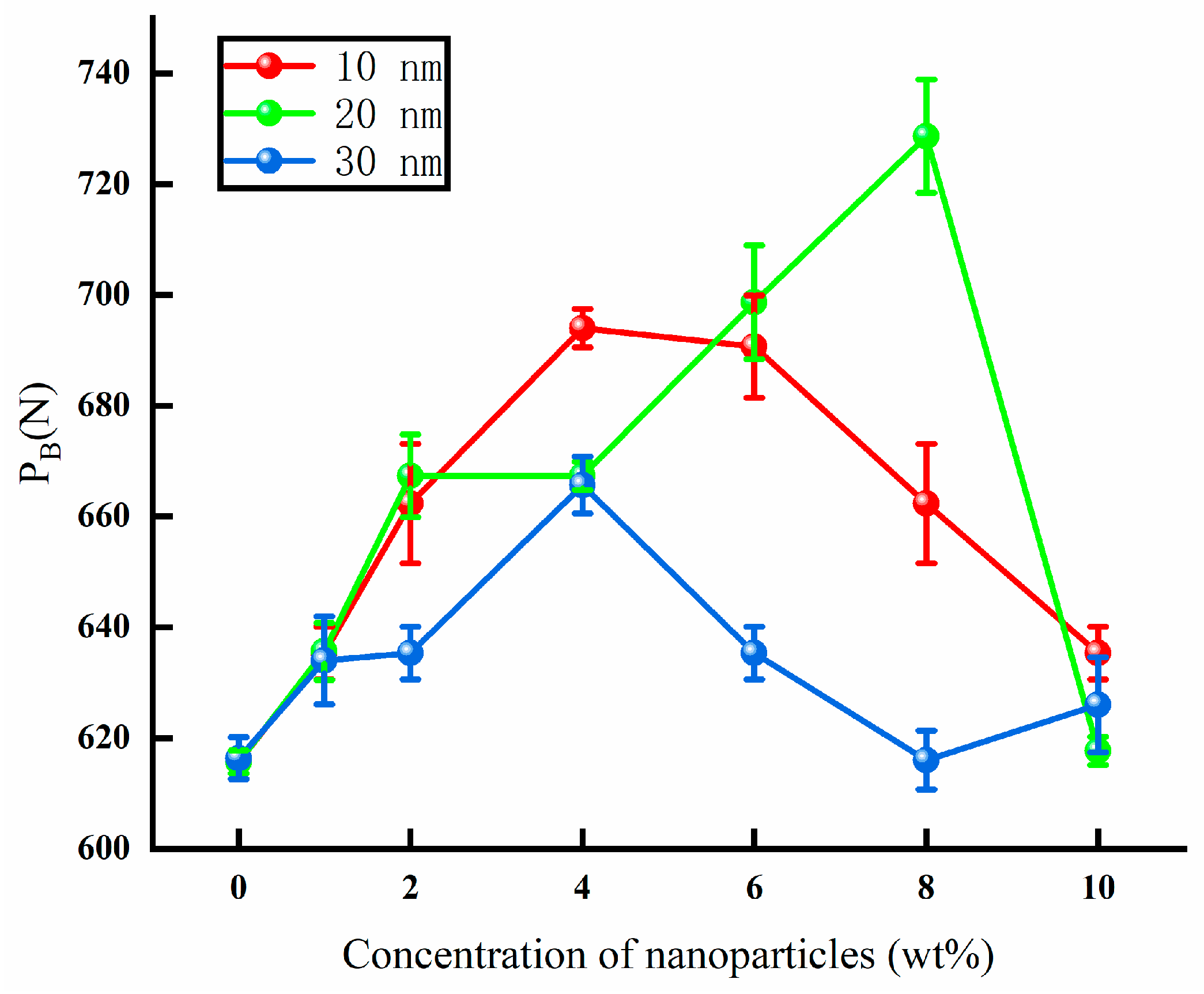
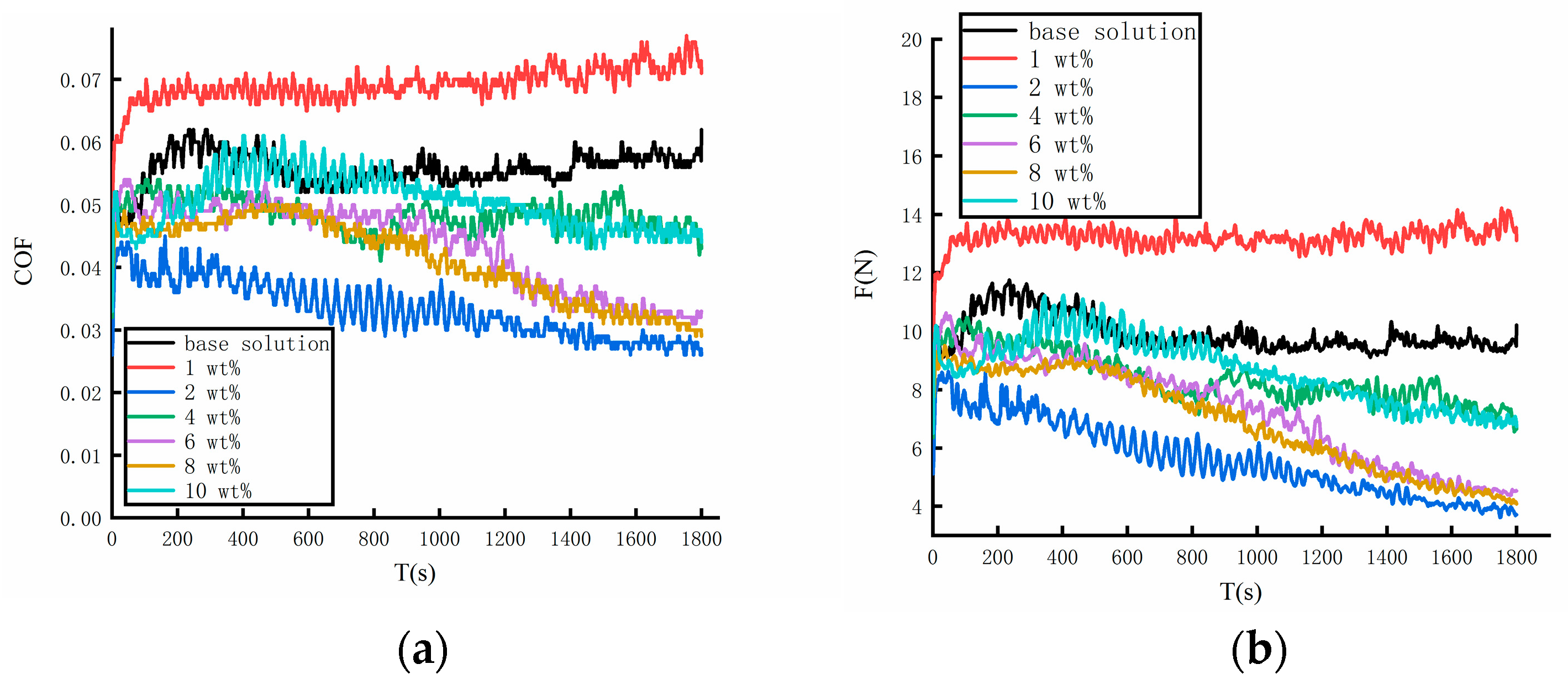
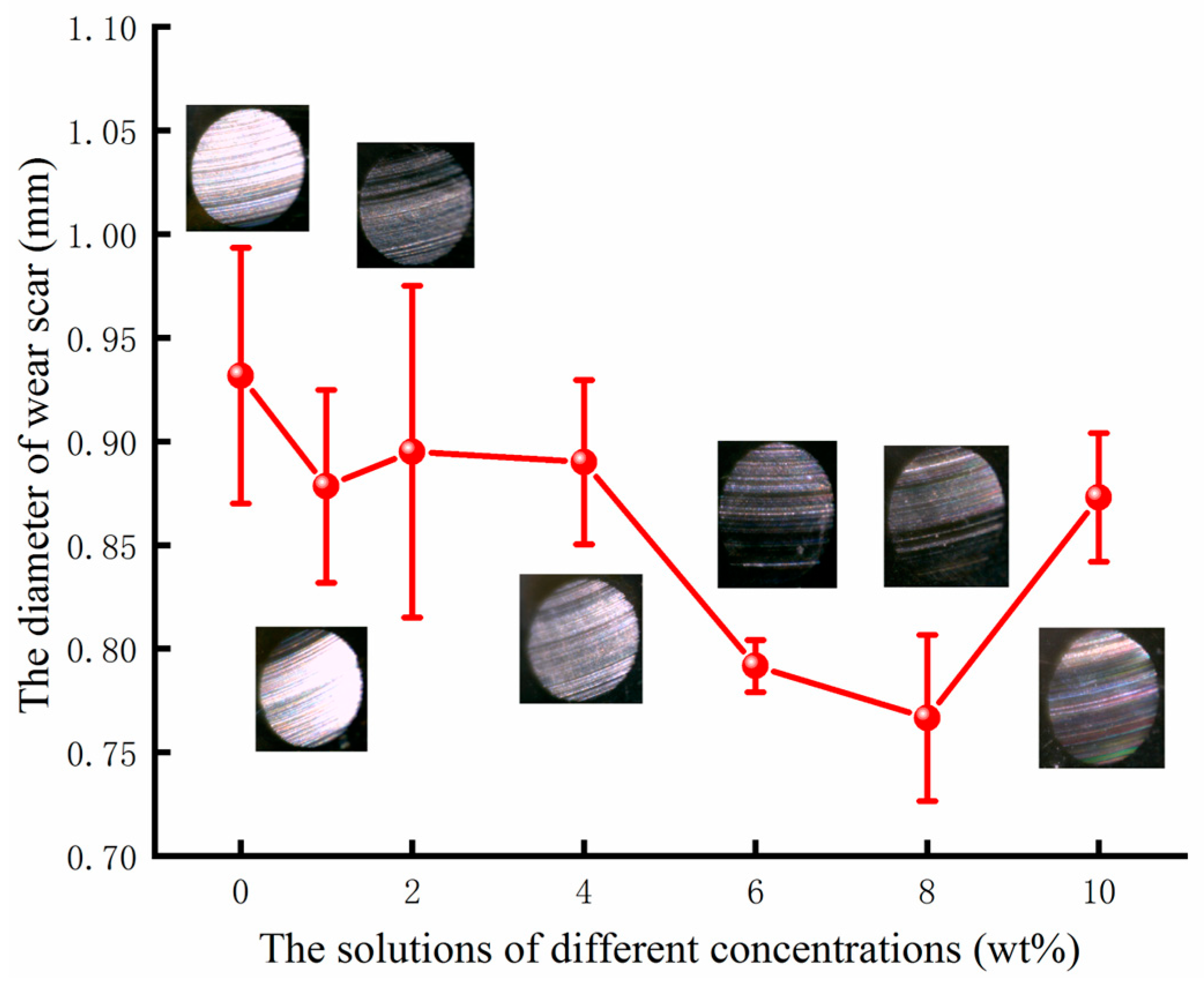

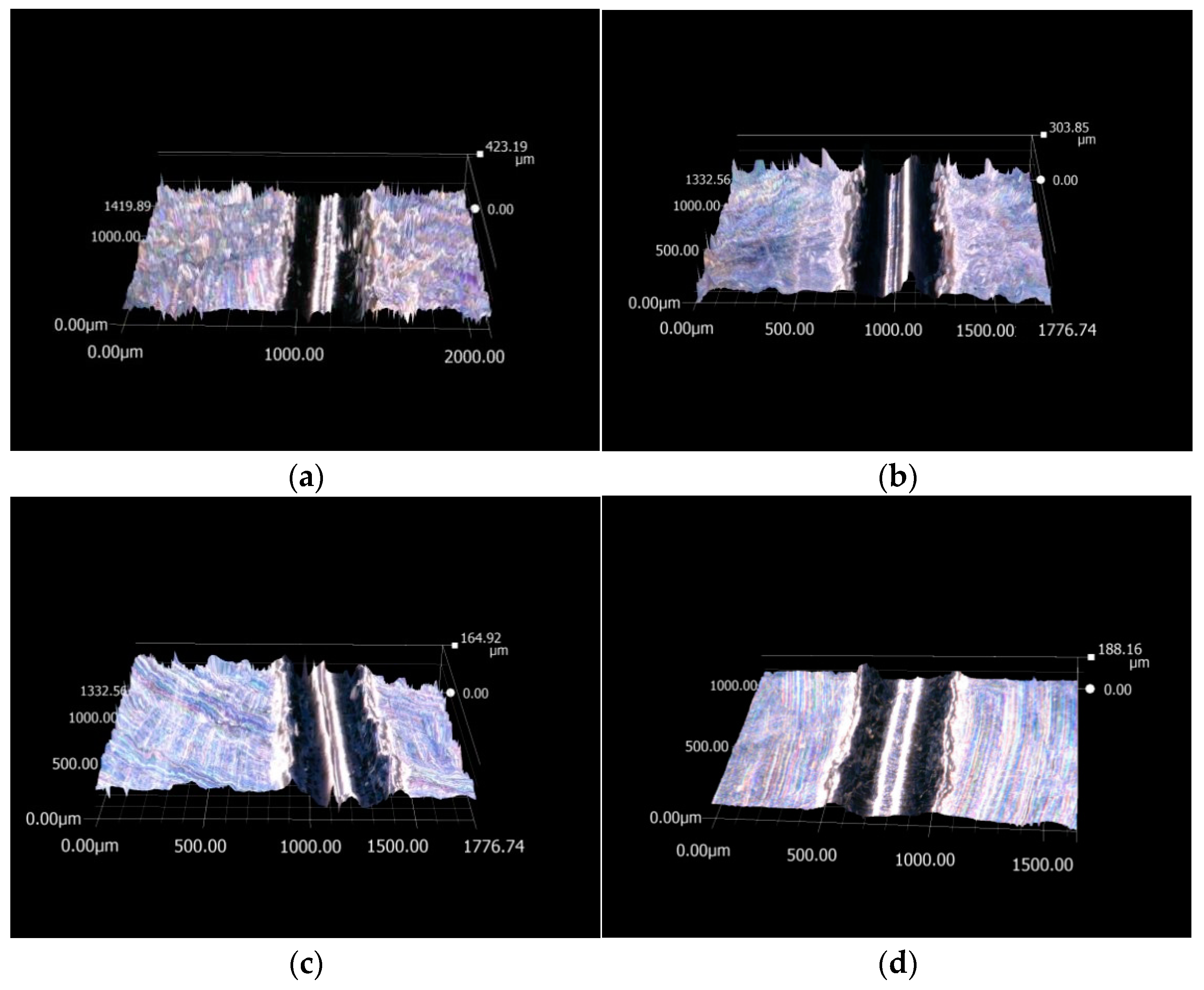
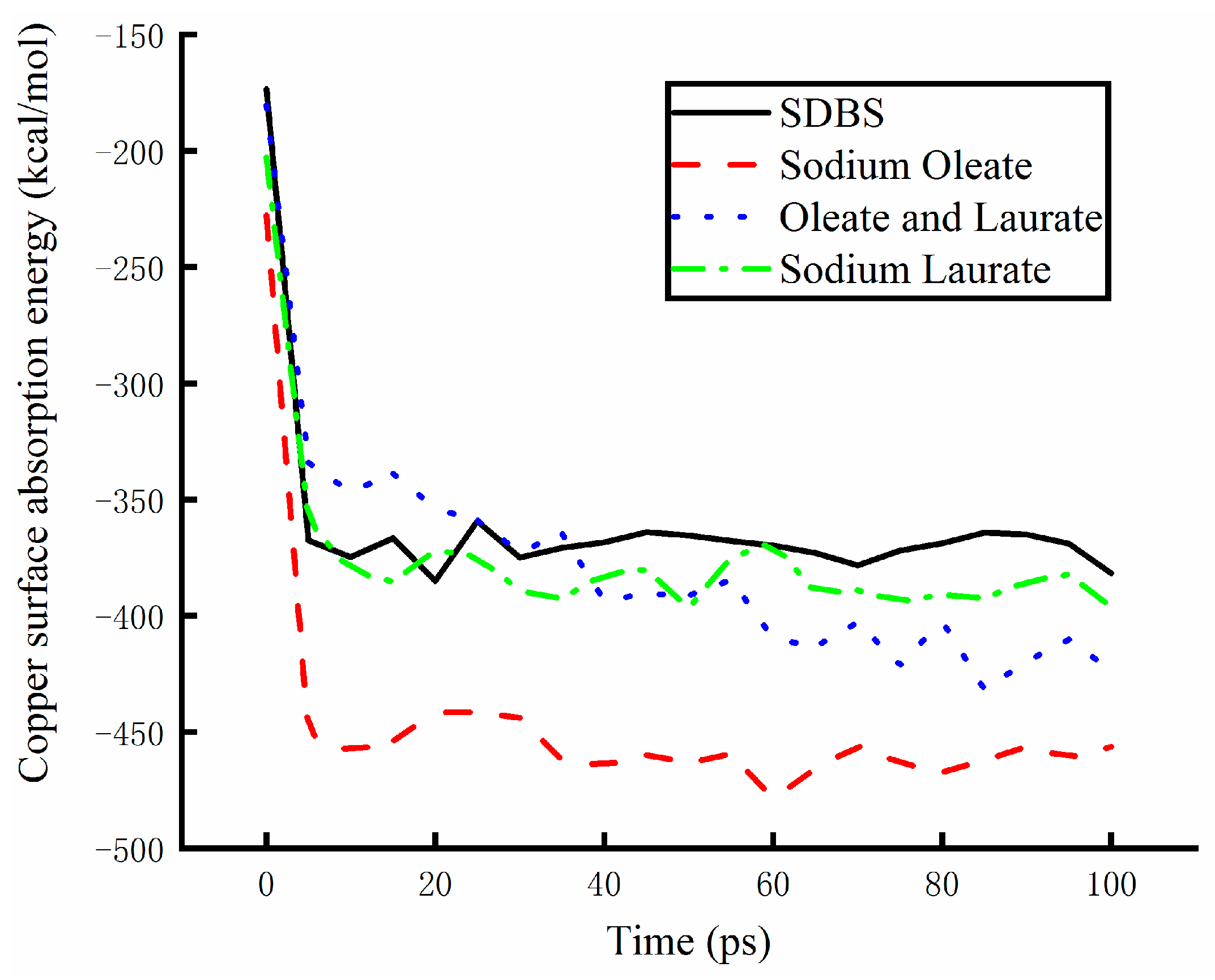
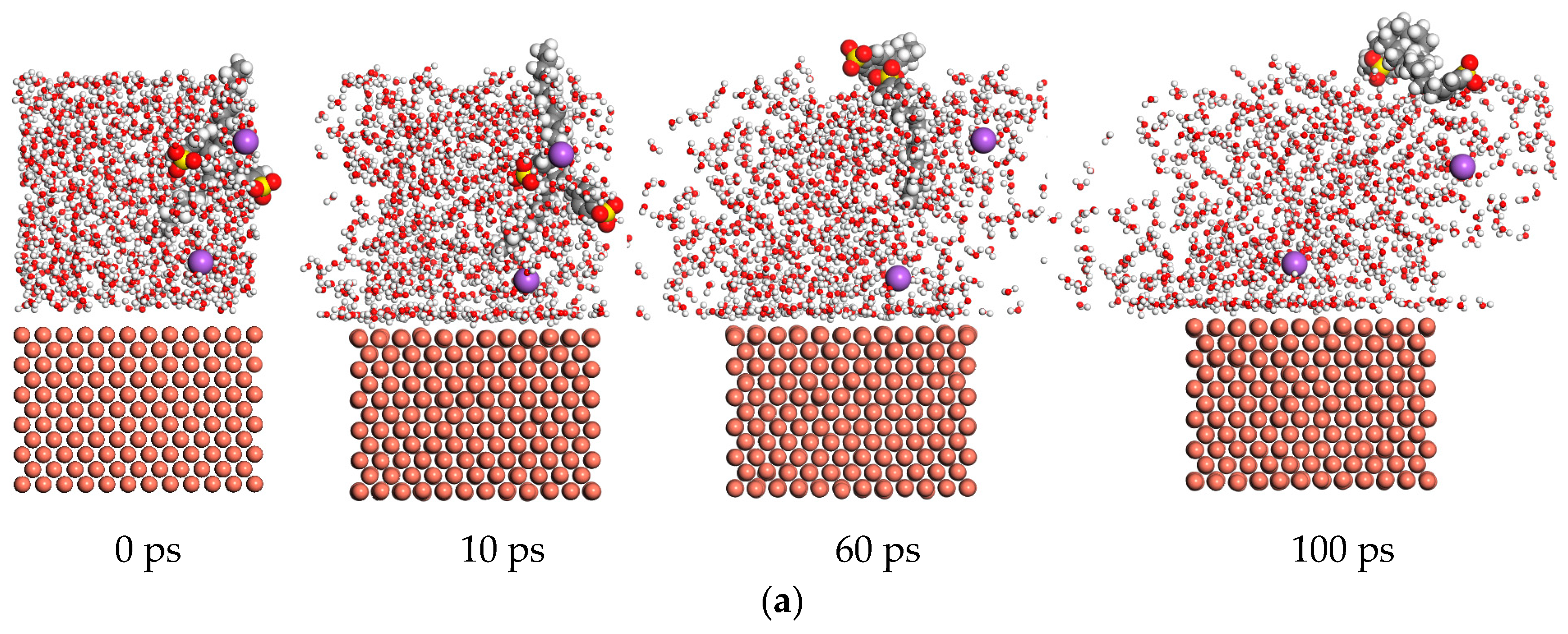
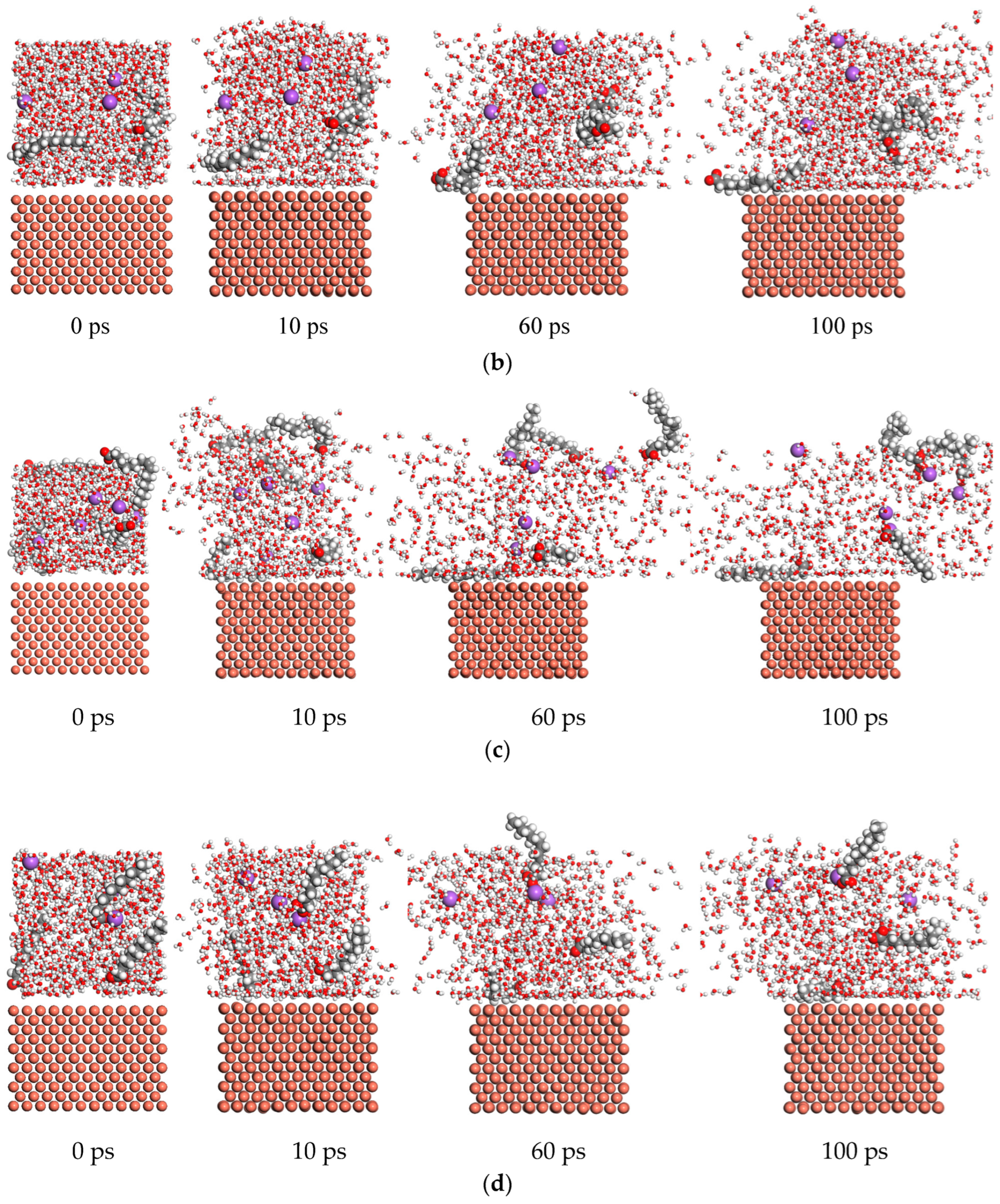
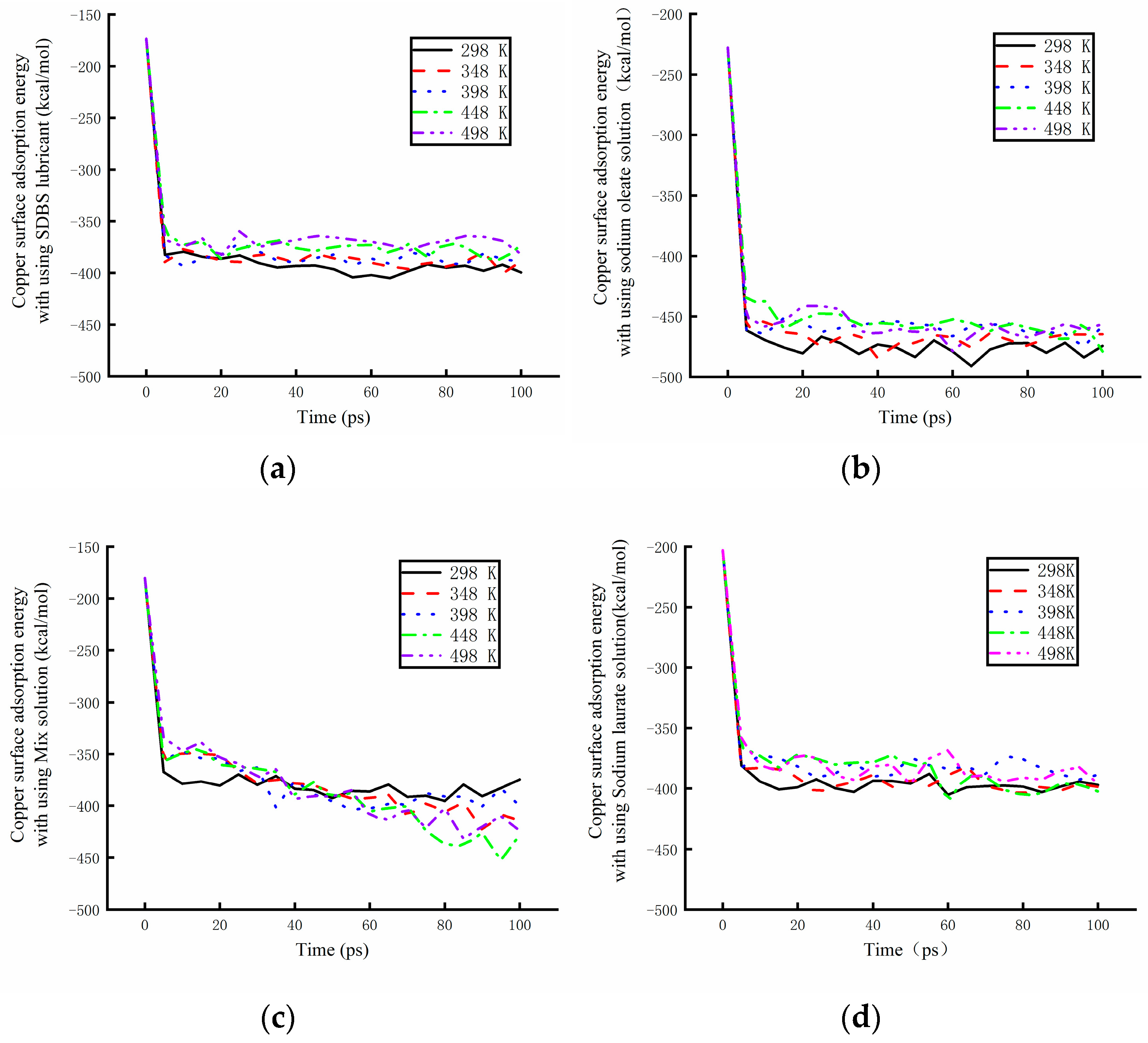
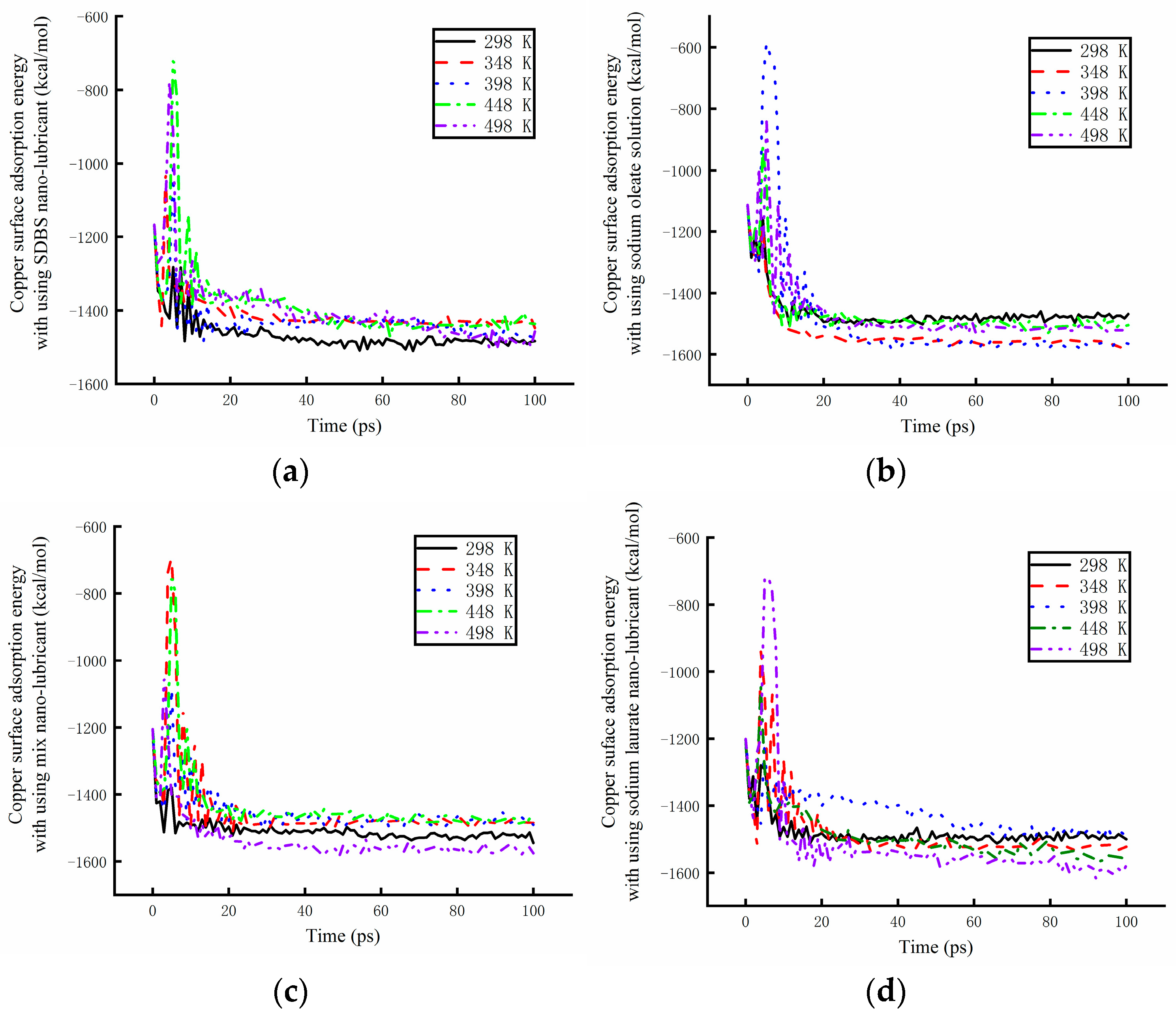
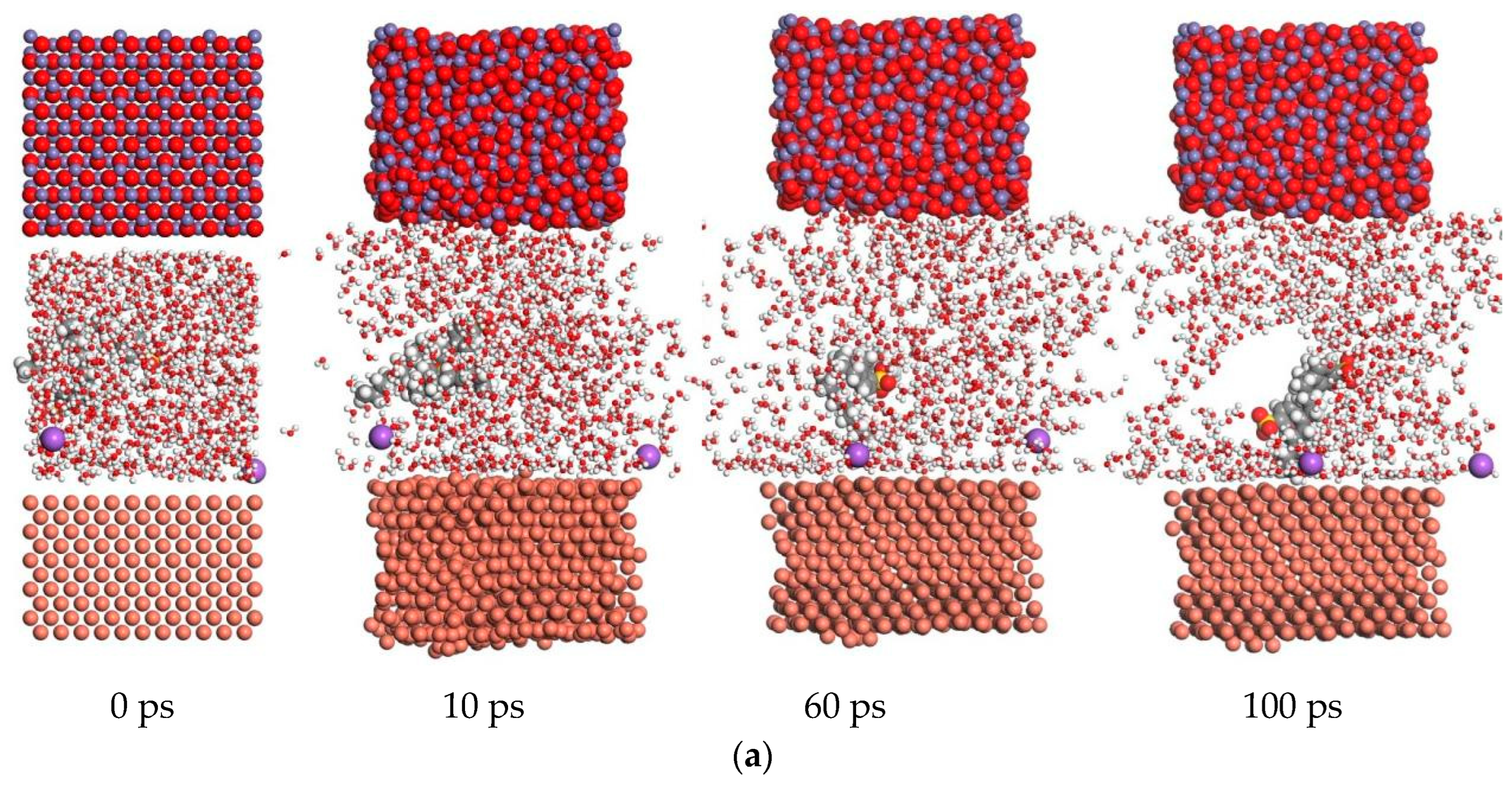


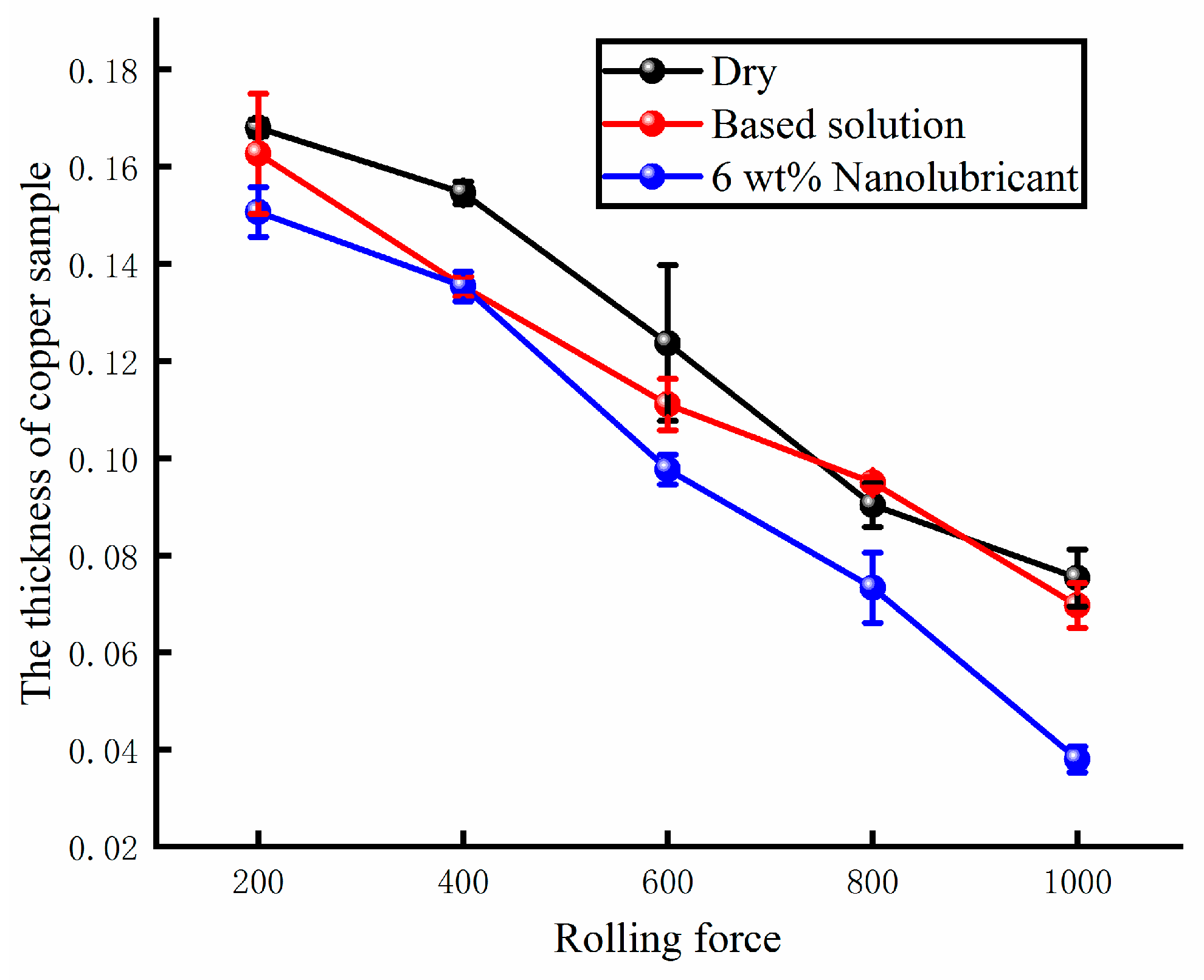


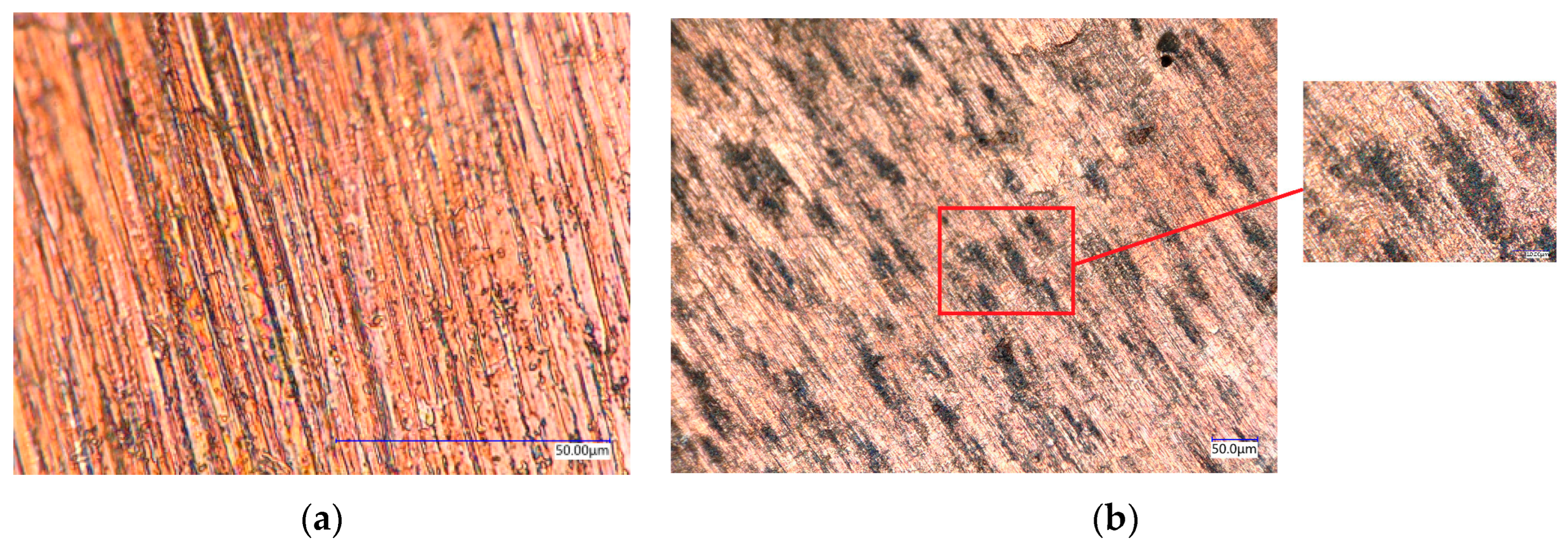
| Atomic Type | Atomic Color in the Numerical Simulation |
|---|---|
| Carbon atom | Gray |
| Hydrogen atom | White |
| Oxygen atom | Red |
| Sulfur atom | Yellow |
| Iron atom | Purple |
| Copper atom | Orange |
Disclaimer/Publisher’s Note: The statements, opinions and data contained in all publications are solely those of the individual author(s) and contributor(s) and not of MDPI and/or the editor(s). MDPI and/or the editor(s) disclaim responsibility for any injury to people or property resulting from any ideas, methods, instructions or products referred to in the content. |
© 2024 by the authors. Licensee MDPI, Basel, Switzerland. This article is an open access article distributed under the terms and conditions of the Creative Commons Attribution (CC BY) license (https://creativecommons.org/licenses/by/4.0/).
Share and Cite
Zhu, Y.; Zhang, H.; Li, N.; Jiang, Z. Preparation, Characterization, and Lubrication Performances of Water-Based Nanolubricant for Micro Rolling Strips. Materials 2024, 17, 516. https://doi.org/10.3390/ma17020516
Zhu Y, Zhang H, Li N, Jiang Z. Preparation, Characterization, and Lubrication Performances of Water-Based Nanolubricant for Micro Rolling Strips. Materials. 2024; 17(2):516. https://doi.org/10.3390/ma17020516
Chicago/Turabian StyleZhu, Yuchuan, Hongmei Zhang, Na Li, and Zhengyi Jiang. 2024. "Preparation, Characterization, and Lubrication Performances of Water-Based Nanolubricant for Micro Rolling Strips" Materials 17, no. 2: 516. https://doi.org/10.3390/ma17020516
APA StyleZhu, Y., Zhang, H., Li, N., & Jiang, Z. (2024). Preparation, Characterization, and Lubrication Performances of Water-Based Nanolubricant for Micro Rolling Strips. Materials, 17(2), 516. https://doi.org/10.3390/ma17020516







